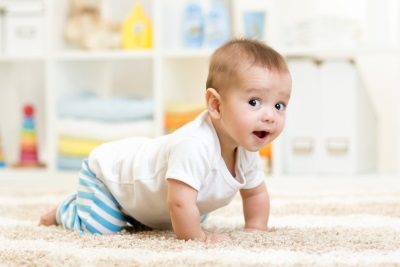When does a baby start to sit by itself?
In the first year of their lives, each child gradually learns many skills. A completely helpless kid first learns to raise and hold his head, grab the toys with his hands, roll over his tummy and back. After mastering these skills comes time to learn to sit.
Standards for boys and girls
It used to be widely believed that girls should be seated much later than boys. This was explained by the possible harm to the bones of the pelvis and the formation of female genital organs. Now pediatricians believe that there is no particular harm to a female child in an early seat, provided that the girl began to try to sit on her own. According to experts, gender does not affect the age at which the child begins to sit himself.
Pediatricians note that the norm for developing the skill of sitting for children of either sex is the range from 6 to 9 months. On average, kids learn sit without support by the age of 7 months. Some children learn this skill a month earlier than their peers, and for someone to sit on their own only by 8-9 months - these are also standard variations.

Stages of skill development
- At 6 months, many babies are sitting with support, leaning with their hands, but at the same time they often collapse to the side and lose their balance. They still do not know how to sit on their own, and are able to sit down only by pulling themselves up by the hands of their parents. To sit at this age, the baby needs only a few minutes to train the skill.
- At 7 months, the babies sit more confidently and often no longer lean on their hands. Sitting, they turn the body to the right and left, keeping the balance of the body. Also, children of this age are already beginning to master the skill on their own, sit down from the prone position with the help of a support with their hands.
- At 8 months, most babies are able to sit confidently and assume such a position from any position lying down, and also to easily change the position.

Should I force the child to sit and the danger of sitting prematurely?
Pediatricians consider the vertical position of the spine at the age of less than 6 months harmful for the formation of the child's skeleton. When seated, parents can harm the health of their offspring, and spinal problems may appear later, for example, at school age. First, the child should strengthen enough the back muscles, and only after that the spine will be able to withstand the load from a sitting position. If the baby rounds the back or falls to the side, it is too early for him to sit.
If the baby has not yet learned to sit on their own, parents should not:
- To plant the crumb, laying around the child of a pillow.
- Carry a baby in a "kangaroo" in a sitting position.
- Carry a child in a stroller while sitting (the back should be at an angle of no more than 45 °).
- Sit the baby on your lap.
Dr. Komarovsky: how to sit the baby and how many months?
The well-known pediatrician advises doctors not to be guided by developmental norms, especially since their range is quite large, but to remember that each child develops at his own pace.
If the baby is healthy, then, according to Komarovsky, parents simply need to create favorable conditions for his physical developmentand the baby will learn to sit by itself.
In addition, a popular doctor emphasizes parents that sitting for a small child is not at all helpful. And the later the baby learns this skill, the smoother the back will be and the better for his spine. Therefore, Dr. Komarovsky advises not to help the baby to sit down, and encourage learning to crawl.
See below for a short video with Dr. Komarovsky’s tips.
The correct position of the child
When the child is sitting correctly:
- His head leans slightly forward.
- His neck is slightly unbent, as is the upper part of the spine.
- His hands are located in front of the body to serve as a support.
- His loin is bent, and the hip joints are slightly bent forward.
- His legs are divorced to the sides and turned outward (the kid rests on their side surfaces).
In another position, the baby will be very tired, and the formation of the natural curves of the spinal column will be disturbed.

Useful exercises that promote sitting
The correct physical development of the baby is promoted by daily gymnastics, swimming in the bathroom (well, if you can additionally attend the pool) and massage. These actions strengthen the muscles.
From 4 months you can start doing the following exercises:
- Put the child on the table, and when he stretches his hands to you, give the crumbs your index fingers. Scarce grabs them and hangs for a few seconds at a 45 ° angle, then lies down again.
- Give the child a position on his stomach, and put his legs on his chest. Put one hand under the breast of the child, and the other under his legs. Hold the child in that position for a few seconds.
- Hang the rings over the infant's crib so that the crumb can learn to grab them and try to pull themselves towards them.
- Laying a crumb on his stomach, a few inches from the child, place a bright toy so that the baby tries to get to it.
Remember that it is safest for a child to sit on all fours. So the spine will be the least loaded.












